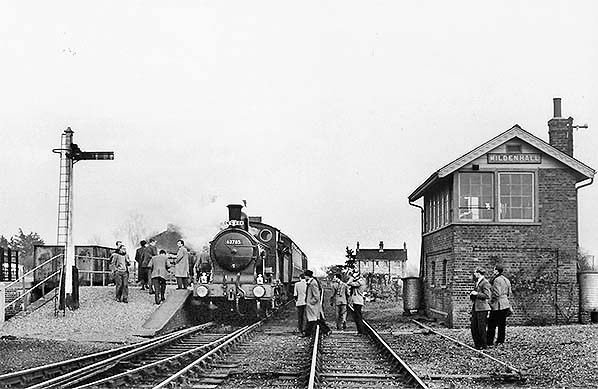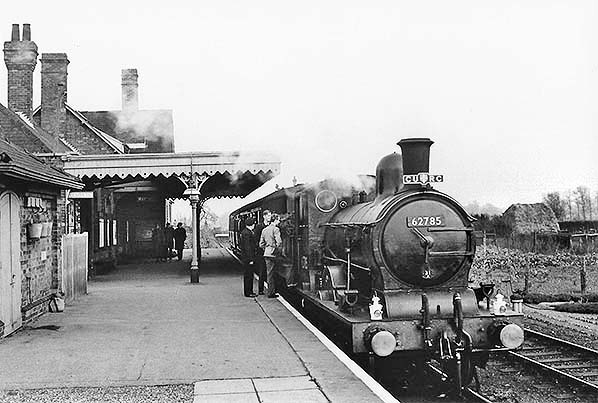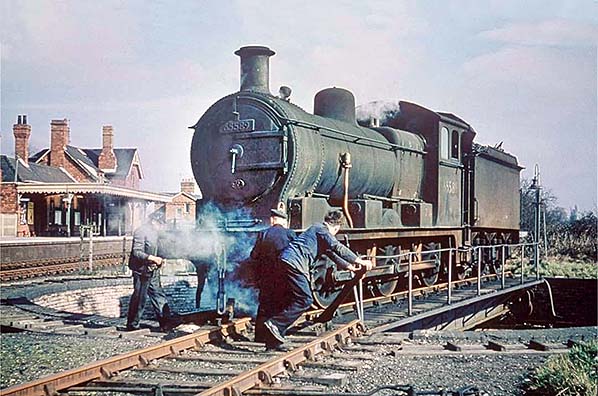
Station Name: MILDENHALL
[Source:
Darren Kitson] Mildenhall Station Gallery 3: April 1959 - August 1964
old7.jpg)
On 25 April 1959, a Metro-Cammell 79xxx DMU waits at Mildenhall. This is the same train which had been photographed at other stations on the branch on the same day. The tail lamp is still in position so the train has only just arrived. The lock-up can be seen and the end of the cattle pen is just visible on the extreme left. The turntable is on the right and a gas lamp was provided,
Cammell 79xxx DMU waits at Mildenhall. Sometime during the BR period, Mildenhall had seen some further rationalisation and this is evident above. The trap points on the run-round loop are still controlled from the signal box but the points for entering the loop are controlled locally by the lever visible directly ahead of the camera. In the distance, left of the DMU, a further upper quadrant signal has appeared. There was also a ground signal, a disc shunting signal, just visible midway between DMU and signal box but this had been installed rather earlier. The original staff cottages are on the right, with the station house beyond. At the time this photograph was taken, the branch was rather unusual in that passenger trains could be either DMU or railbus but with steam still putting in occasional appearances. A similar situation prevailed on the Stour and Colne Valley lines but only for the purposes of changing over railbuses at Witham. Normally when railbuses took over a particular line they, and only they, operated the service unless a failure had occurred or a special event required extra capacity.
Photo by David Pearson old8.jpg)
The same Metro-Cammell unit as above is seen from the signal box. The tail lamp has been removed from this end of the DMU, the guard will have dealt with that, but the destination blind has yet to be changed. No doubt the driver will see to that when he enters the cab for the return to Cambridge. Metropolitan-Cammell and its predecessors had been building railway rolling stock of one form or another for decades before BR was formed. It was therefore no surprise that when these DMUs appeared in 1955 they performed almost faultlessly and gave very little trouble during their relatively short careers. Indeed, the later Class 101 version, which differed from the 79xxx version in a number of ways, went on to become the last of what we now call Heritage DMUs on the national network - apart from a couple of Pressed Steel Class 121 single cars which were refurbished for dedicated routes. At Mildenhall in 1959 the staff gardens clearly are well tended and some sections of ceramic piping have been put to use as planters. All staff cottages are visible as is the lock-up and the gas lamp external to the canopy. Human activity is, however, conspicuous by its absence.
Photo by David Pearson  Mildenhall on 28 November 1959. The occasion is a Cambridge University Railway Club special using the very last 2-4-0 locomotive to run on mainland Britain's national network; Class E4 No.62785. Looking spruced-up and carrying an express headcode with equally spruced-up lamps, she was withdrawn from service immediately afterwards (officially w/e 30 November 1959) to enter preservation albeit not with a tender cab. Modern Health & Safety regulations would not permit the sort of activity seen above, even on a branch line. Where properly organised railway clubs were concerned BR were usually very good regarding special trains, brake van permits, site visits and so on.
Photograph by Peter Jamieson and reproduced with his kind permission 
The rare sight of two trains in the platform at Mildenhall during the visit by the Cambridge University Railway Club special on 28 November 1959 which is seen in the background. The front train is the branch goods waiting to return to Cambridge with, on this occasion, a single van and brake van. The train would pick up other wagons along the way and could be quite lengthy by the time it reached Cambridge. In the 1950s the branch goods left Cambridge around (precise timings varied slightly over the years, hence 'around') 10.30am and did not arrive back at Cambridge until around 6pm. The timing at certain goods yards was tight but at others it was generous. It was allowed two hours at Mildenhall; arriving around 1pm and departing around 3pm. After closure to passengers the branch goods didn't need to slot in with branch passenger trains and with a by-then-dwindling amount of goods traffic it frequently ran early - to the annoyance of the unwise who were hoping to catch it on camera. The branch goods locomotive on 28 November 1959 was Ivatt 2MT No.46467. A number of these useful little locomotives were allocated to Cambridge; 46465/6/7 from brand new with others moving to 31A subsequently. Cambridge had seven in total although not all at the same time; 46468/9 were briefly at Cambridge before being replaced by 46400/94. All the Ivatts worked on the Mildenhall branch but because of dieselisation only 46465/6/7 ever worked timetabled passenger trains. Because the Ivatts came to Cambridge quite late in the steam era, especially the later transfers, they were rarely photographed on the branch and photographs known to exist at the time of writing can be counted on one hand. That seen above, 46467, left Cambridge in October 1961 after ten years at the shed for the Scottish Region. She was withdrawn from Dumfries in July 1964. Seven survive in preservation but none are ex-Cambridge examples.
Photograph by Peter Jamieson and reproduced with his kind permission

Other images of this train at Mildenhall show it drawn forward to the end of the platform, so this view was probably taken immediately after the locomotive had been turned and coupled to this end of the train. However, there was also a goods train present at the time which also required platform space.'
Photograph by Peter Jamieson and reproduced with his kind permission old24.jpg) Mildenhall station during a quiet moment, of which there were many, on an unspecified date. However, as the platform edge has been repainted we know that the image is no earlier than summer 1956. The flower beds on the platform appeared sometime between October 1954 and April 1955. All the features familiar at this time can be seen: gas lighting; the ornate lampshade outside the canopy; the lock-up with little worth locking up.
Photo from John Mann collection old5.jpg)
On 5 March 1960 Class J17 No.65589 shunts at Mildenhall. The car parked beside the lock-up appears to be the same one seen in another colour view of a J17 at Mildenhall, so that image may have been taken at on the same day and of the same locomotive. Withdrawn in January 1961, No.65589 was a Bury St Edmunds locomotive until transfer to Cambridge in February 1955. New in January 1911, she thus gave exactly fifty years’ service. Note the XP rated van behind the tender. This rating was introduced in the 1930s and stood for 'Express Passenger'. Vans so-rated had to comply with certain requirements concerned with wheelbase, braking, axle boxes, couplings and could often be seen attached to local passenger trains including DMUs. The meaning of 'Express' in the railway context is frequently misunderstood. It does not specifically refer to trains which tear along at 100mph or more but to trains which do not stop at many places, if any, en-route. In later years the first down train of the day from Cambridge to Mildenhall did not stop until Fordham; it was therefore an express even though it did not whizz through Fen Ditton Halt at 100mph! Even so, XP rated goods vans could travel at speeds higher than those of stock not so rated and this was useful for loads which needed to reach their destinations quicker and it also made better use of the railway's assets. The van seen above could have originated anywhere and has completed the last leg of its journey in the plodding Mildenhall branch goods train. At least one photograph exists of such a van marshalled into a Mildenhall branch passenger train and between locomotive and carriages.
Photo copyright Colour-Rail 360095
 With the station visible on the left and the signal box behind the camera, Class J17 0-6-0 No. 65589 is being turned on Mildenhall's 50ft turntable in readiness for the return to Cambridge with the branch goods train in March 1960. The three men present will be the driver, fireman and, with his back to the camera, most likely the guard. The Class K goods departed Cambridge at 10.30am, calling at Brookfields (Cambridge cement works), Cherry Hinton, Fulbourne, Newmarket, Fordham and Isleham before reaching Mildenhall at 2.22pm. Departure from Mildenhall was at 2.55pm and the journey back to Cambridge was via Burwell with all stations served but with Swaffham Prior and Quy served on an as-required basis. At Bottisham & Lode the goods would cross what was in 1960 the 4.40pm Cambridge - Mildenhall passenger train, booked at this time for a diesel railbus. Arrival of the goods at Cambridge finally occurred at 5.41pm. The Holden J17 class had begun life as Great Eastern Railway Class G58 with No. 65589 originally being GER No. 1239 and throughout her life was always numerically the final class member, being one of the final pair to be built, new ex works in January 1911 along with No. 1238. She was withdrawn from Cambridge shed on 2 January 1961 after a working life, to the nearest month, of fifty years. Readers should be aware that timings for the Mildenhall goods are from the June - September 1960 Working Timetable. The timetable current in March 1960 may have had minor timing variations but the general pattern for the branch goods remained the same for many years until 1964 when, Fordham - Burwell excepted, the line closed.
Photo by JR Besley  A Waggon und Maschinenbau diesel railbus stands at Mildenhall during, apparently, rush hour. The railbus is E79961 but no other details, such as date, are known but E79961 is known to have been given warning flashes by 1961. Shadows tell us the photograph was taken during late afternoon or early evening but without knowing the precise date we are none the wiser. Visible under the canopy is the station clock; under magnification the clock shows either 11.20 or 3.55. During the period railbuses appeared on the branch no trains arrived at Mildenhall at either time although the summer 1958 timetable did have an 11.24am Saturday-only arrival. However, if it was that service it has arrived early but this does not concur with the shadows which tell as it is later in the day. In any event, the railbuses were still new in 1958 and warning flashes had not then been applied. Perhaps the station clock was not working. The people on the platform are all wearing coats, suggesting the photograph was not taken during the summer and this is backed up by the windows of the railbus all being closed. The women, who appear to be about to board the railbus, are all wearing hats. This does not signify any special occasion as at one time it was normal practice for women to wear hats, or Hilda Ogden style scarfs, when they went out.
Photo from John Mann collection old21.jpg)
On Friday 15 June 1962, penultimate day of the passenger service, a Waggon und Maschinenbau railbus has arrived at Mildenhall. Other than the date, no other details accompany the image but more information can be established. Two of the WMD railbuses, as BR referred to them, received smaller yellow warning panels than the remaining three and these were E79960/3. Of the remaining three, E79964 still had whiskers when the branch passenger service was withdrawn and photographs of it on the branch in this condition exist, taken during the final week. Overhead warning flashes and data panels were applied rather haphazardly and varied in position throughout the class. From these observations, the railbus seen above is E79960 which at the time had only just received its yellow panels and flashes. The triple tone warning horn can be seen; sometimes known as 'Typhoon' horns, they were referred to by BR as 'Makrofan' horns which was a misspelling of the German word 'Makrofon'. The proper buffing and drawgear is also clearly visible. The screw coupling was similar to the British design but slightly smaller. It was, however, compatible. BR specified proper buffing and drawgear on these but no other passenger railbus types. The reason was because BR considered ordering some trailers but the idea came to nothing. The pipes below the bufferbeam were for compressed air; these railbuses could operate in tandem but not in multiple, unlike their German Uerdinger parents. The above image is known to have been taken during the evening and the railbus has just arrived from Newmarket and will return from Mildenhall at 7.31pm to Newmarket and then, later, Cambridge. No photographs of railbuses at Newmarket or between there and Cambridge have come to light so images such as this are the only evidence we have that they did operate to and via Newmarket. BR's railbuses are generally considered to have been a failure. In truth it was policy and application that were failures rather than the vehicles themselves and this point cannot be better made by the fact almost 900 of their various types operated in Europe, the majority in Germany, with some still going strong in the 21st century. The above view affords us a better look at the ornate gas lamp, another of which can just been seen further along the canopy. On the right can be seen the neatly tended staff gardens
Photo copyright Colour-Rail DE-39 old1.jpg) A forlorn Mildenhall station on 26 August 1964. The passenger service had ceased two years previously, immediately after which the platform canopy and other station fittings had been removed. Brush Type 2 diesel D5662 had departed Mildenhall with the final goods train on the Fordham - Mildenhall and Burwell - Barnwell Junction sections during the month prior to this photograph being taken. Track-lifting was in progress but the platform road is in situ; it would not remain so for long. A Ford Corsair is parked beside the lock-up and this building, plus the adjacent gent's toilets, would be gone by 1971. In the foreground is the turntable pit. The turntable itself had been removed, it is believed, in 1962 following the end of steam in the region. It is not known if the rubble was accidental or if the pit brickwork was being demolished. Either way, the outline of the infilled pit and of the locomotive pit remained visible from the air in 2015. The dark line around the bottom of the pit wall was where the circular rail on which the turntable ran was located and the rail itself had been removed by this time. The turntable rotated about a central pivot and it is possibly the remnant of this pivot which is partly visible at bottom right. Photo from the Geoff Plumb Collection of original slides Click here for Mildenhall Station Gallery 4:
|
old9.jpg)
 Home Page
Home Page